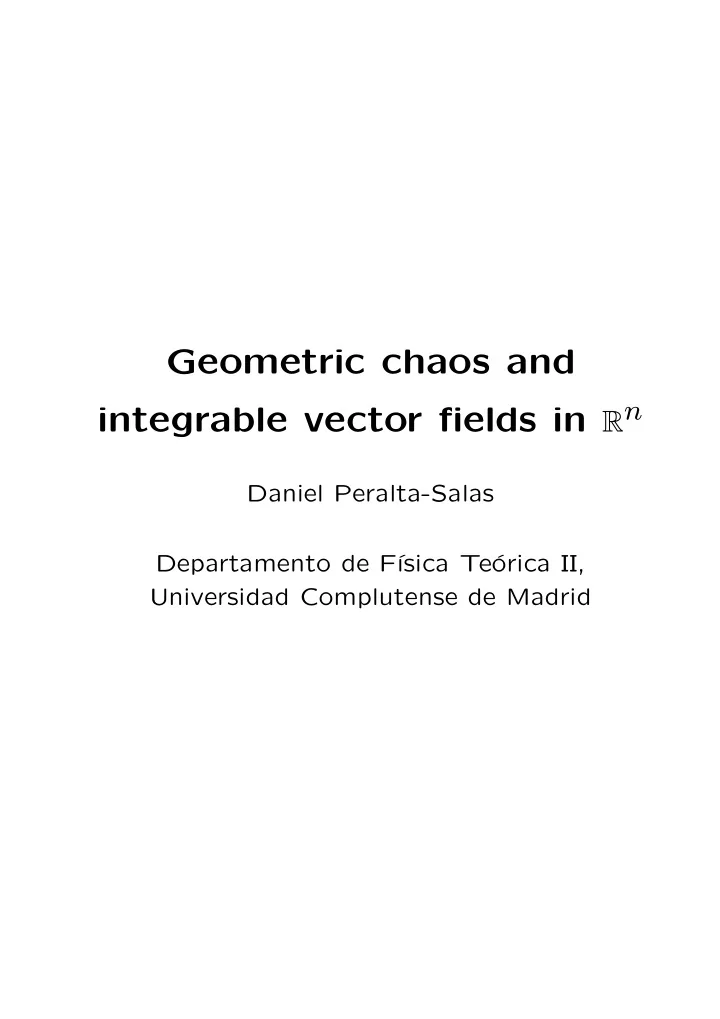

Geometric chaos and integrable vector fields in R n Daniel Peralta-Salas Departamento de F ´ ısica Te´ orica II, Universidad Complutense de Madrid
x ∈ R n , X ∈ C ∞ ( R n ) (or C ω ) x = X ( x ) ˙ ⇒ orbit on R n . Solution: φ ( t ; x 0 ) ( t ∈ R ) = First integral : f : R n → R such that X ( f ) = X ∇ f = 0. Symmetry vector : S such that [ S, X ] = λX for some smooth function λ : R n → R . Invariant set : Σ ⊂ R n such that φ ( t ; Σ) ⊂ Σ for all t ∈ R . Some types of orbits: critical points, periodic, quasi-periodic and dense. 1
Topological boundary F = { P ∈ R n such that for any neighborhood N ( P ) of P there are points Q, Q ′ ∈ N ( P ) for which the orbits of X through Q and Q ′ are bounded and unbounded respectively } . Geometric chaos : bounded and unbounded orbits are both dense on some open subset of R n , and hence F is an open set. Other types of complex boundaries: fractal and Cantorian. Classical example: Arnold’s diffusion ( g ≥ 3) = ⇒ Cantorian boundaries. 2
Geometric chaos is possible even if X has 1 ≤ r ≤ n − 2 first integrals. Let X be a vector field with r (independent) first integrals f = ( f 1 , . . . , f r ) such that the level sets of f on some open set U ⊂ R n are tori T n − r . Assume X � = 0 on U and that the orbits of X on these tori are periodic or quasi- periodic depending on the values of f . Let L r be a properly embedded r -dimensional half-plane diffeomorphic to [0 , ∞ ) r and which transversely intersects each tori in U just once. There is a smooth diffeomorphism Φ : R n \ L r → R n , and hence we can define the vector field ˜ X transformed of X | R n \ L r under Φ. ˜ X has geometric chaos. 3
Let X be a Hamiltonian vector field on R 2 g . Assume X is Liouville-integrable , i.e. it has g independent first integrals { f 1 , . . . , f g } in in- volution and the Hamiltonian vector fields X f i are all complete. Theorem : Geometric chaos is not possible. If X is Liouville-separable then it can be inte- grated by quadratures. In the analytic category the boundary is a semianalytic set. F is formed by “interior” and “exterior” components. Examples: Henon-Heiles potential, Stark ef- fect, straight-line wire. 4
X is completely integrable if it has n − 1 independent first integrals f = ( f 1 , . . . , f n − 1 ). f : R n → R n − 1 defines a submersion, and its level sets are properly embedded curves diffeo- morphic to S 1 or R . Examples: vector fields with many symmetries. Any (smooth or analytic) link can be the zero set of f (Miyoshi). f has cyclic orbits if and only if the second homotopy group of the leaf space is not trivial (extension of Smith’s exact sequence). Theorem : F is and unbounded closed set in R n , foliated by open orbits of f , and of dimen- sion 1 ≤ dim F ≤ n − 1. In particular geometric chaos is not possible. 5
Old open problem: if f is analytic can the boundary F be fractal or Cantorian ?. The answer is yes. Let f be a submersion with S 1 orbits. Define the set Σ homeomorphic to [0 , ∞ ) m and non- differentiable at any point (Weierstrass-type set). Assume that Σ intersects just once each closed orbit on certain open set U . The com- plement of Σ in R n is analytically diffeomor- phic to R n (Morrey-Grauert theory). The same happens if Σ is homeomorphic to [0 , ∞ ) m × T ∞ , where T ∞ is the Cantor set. Transforming f | R n \ Σ via the analytic diffeomorphic we get a new analytic submersion with fractal and Can- torian boundary. This construction does not yield polynomial submersions, in fact if f is polynomial the bound- ary F is semialgebraic (Jelonek). F being fractal or Cantorian is not an struc- turally stable property in general. 6
Open problems : 1. Examples of submersions with S 1 orbits. 2. Is geometric chaos structurally stable?. 3. Analytical criteria for ensuring that F is a “nice” set. 4. Physically relevant examples of integrable systems exhibiting geometric chaos or frac- tal/Cantorian boundary. 7
References : [1] A. D ´ ıaz-Cano, F. Gonz´ alez-Gasc´ on and D. Peralta-Salas: On scattering trajectories of dy- namical systems. J. Math. Phys. (2006). [2] G. Hector and D. Peralta-Salas: Topologi- cal boundaries of completely integrable vector fields of R n . Preprint (2006). [3] D. Peralta-Salas: Topological transitions in classical Mechanics. Preprint (2006). 8
Recommend
More recommend